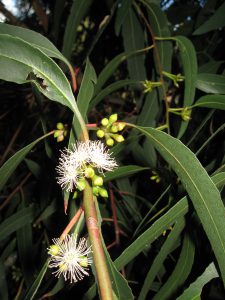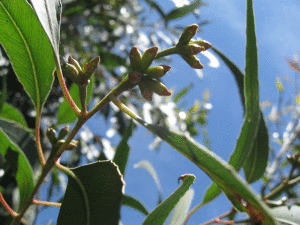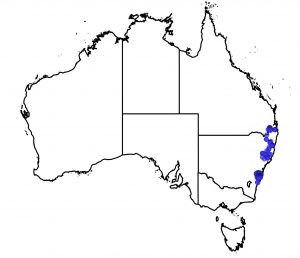Phone: 03 577 2395
C/- Marlborough Research Centre Trust, PO Box 875, Blenheim 7201


Eucalyptus quadrangulata (White-topped box) is a very fast early grower which produces Class 2 durable timber. It is suited to fertile, moist sites. NZDFI is currently testing its potential as a component of laminated veneer lumber (LVL).
Matching eucalypt species to site is essential for good tree survival and growth. Make sure you know your proposed planting site, then talk to an experienced grower or nurseryman before purchasing trees.

E. quadrangulata buds and flowers.

E quadrangulata buds.

7 yr old E. quadrangulata.
Follow our establishment guidelines for good establishment success.
E. quadrangulata requires form pruning. Fast early growth means this should be done at age 1-2 years. Little clearwood pruning should be necessary if growing post and pole wood. For high quality sawlogs, clearwood pruning at an early age is necessary.
Read our form-pruning guidelines and watch some videos.
E. quadrangulata is susceptible to two pests currently found in New Zealand, paropsis beetle and Eucalypt Variegated Beetle (EVB). NZDFI research has shown some families are more tolerant to pests than others. Breeding selections will include pest tolerance in future.
E. quadrangulata flowers in late summer/autumn.
Note: Durability is a complex parameter; NZDFI’s research into heartwood formation will improve our understanding of factors determining durability.
Structural uses, poles and posts, crossarms, railway sleepers, vineyard and fence posts.
NZDFI have also been researching the potential for E. quadrangulata as a component of laminated veneer lumber (LVL).
E. quadrangulata's natural range is the coast and adjacent ranges of New South Wales and Queensland.

E quadrangulata was selected for the NZDFI breeding programme based on its high durability and very fast good early growth in NZDFI trial plantings in Marlborough.
Historically there is very limited experience of growing E. quadrangulata in New Zealand. It has been established on sites from Northland to Marlborough and shown excellent early growth.
The best trees exhibit excellent form.
It is performing well in early NZDFI trials (2003-04 plantings) in Marlborough, and various other NZDFI trial plantings.
E quadrangulata is a leading species in NZDFI’s breeding programme.
There had been no genetic improvement of E quadrangulata before being selected by NZDFI.
Read more about our breeding programme here.
The following wood properties relate to Australian native timber. Data for NZ plantation timber are not yet available.
C/- Marlborough Research Centre Trust, PO Box 875, Blenheim 7201